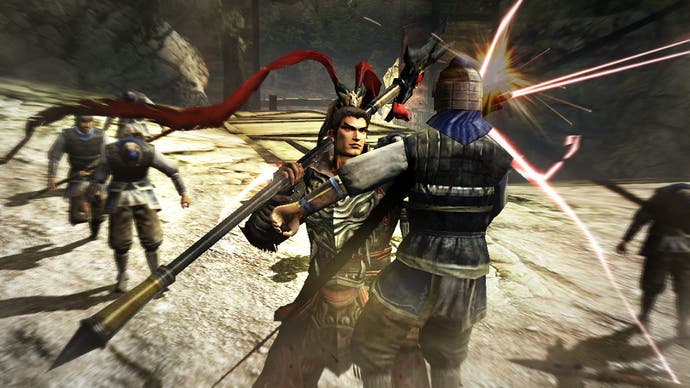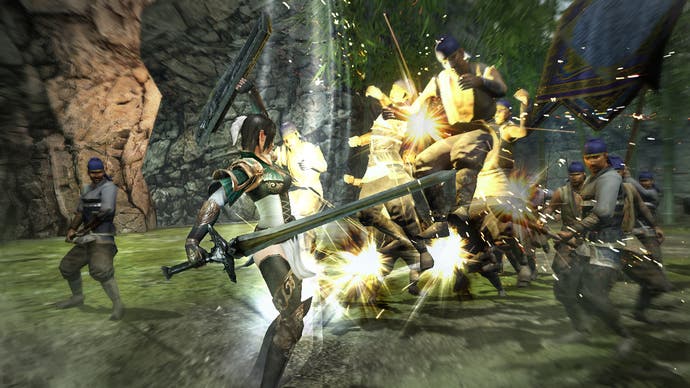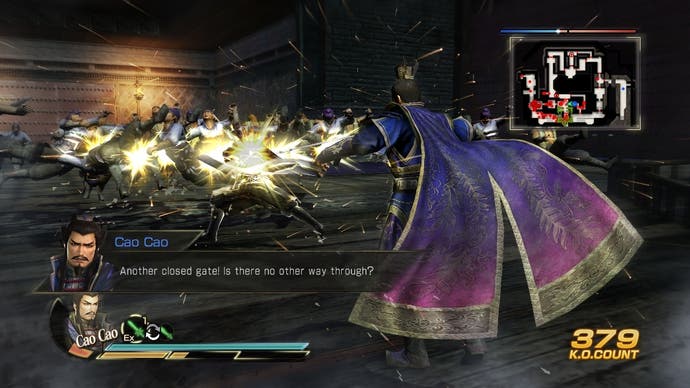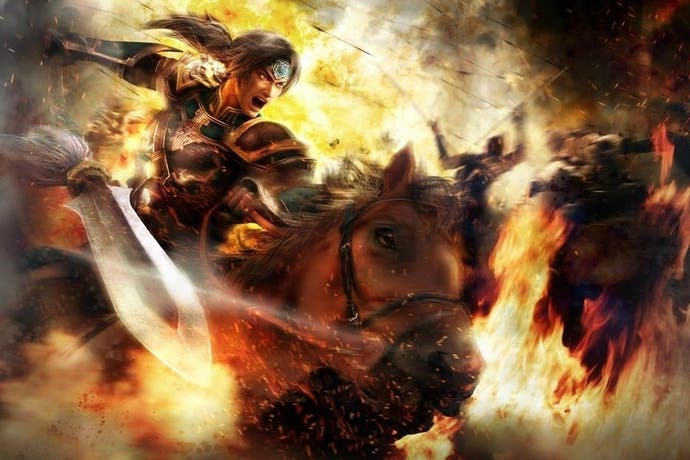Dynasty Warriors 8 review
A feudal good men.
"8" seems like such a small number when you consider that this new Dynasty Warriors game is really something like the 35th title in its lineage. Tecmo Koei's massive battle series is an unsung hero of the middle tier, proving that a fanbase can sustain a vibrant bloodline throughout an entire console generation without having to compromise its central values and peculiarities.
Dynasty Warriors 8 is still very much about en-masse historical fisticuffs, where thousands of units take part in battles, the flow of which you are superhumanly capable of influencing, and thanks to a few changes - a new weapon system, new combo specials, better visuals and an intriguing new "Ambition" mode - it will continue to serve those fans very well.
Then again, that kind of loyalty can be a double-edged sword. It hasn't prevented Dynasty Warriors' developers from trying new things, but it does mean they rarely think about tidying themselves up for new players.
For instance, Dynasty Warriors 8 suffers from a lot of issues that are nothing new to the series, like the irritating scattered survivors you see when running back and forth across the battlefield, and the fact you still spend an awful lot of time running around these huge, emptying warzones when in an ideal world you would be firing up the old chop-chop-boom combos instead.
The combination of big stages and a terribly dense mini-map means there's a high chance of getting lost, even with knowledge of the environment. Dynasty Warriors has always had a perverse obsession with making the player trudge around (particularly if they lose the beat of a stage's rhythm) but in Dynasty Warriors 8 it feels excessive, even to an old hand. Why not do something about all this?

These aren't the only drawbacks, either. There are a few noticeable scripting and AI bugs, and more worryingly the introduction of a new deferred rendering graphics engine has apparently been responsible for an influx of slowdown. It's the weirdest slowdown I've ever seen, with v-sync still locked so frames aren't actually dropped; sometimes it's as though you're fighting in the vicinity of a black hole. It happens in the oddest places and seems to bear little relation to how much is happening on-screen.
Dynasty Warriors 8 also continues the series' frustrating tradition of burying a lot of its best features, but we'll get to that a bit later. For now, let's switch polarities and talk about the good stuff. Namely, that the fighting is still fabulous.
Everyone in Dynasty Warriors 8 carries two weapons. You can switch between the two of them in battle, as per the last game in the series, but now there's an arbitrary but neat new system called "Officer Affinity" to govern them. It's ostensibly rock/paper/scissors, but it works to add a nice amount of tactical spice and variation.
Enemy officers are now accompanied by an icon that signals whether your current weapon's Affinity offers an advantage over them. If you're at an advantage, it's woo time. You'll do more damage and, given enough duffing, you'll trigger a fancy Storm Rush combo, a special attack that tends to KO the opponent. If you're at a disadvantage, you can switch weapon, prompting a nifty mini-combo. Switch at the right time and it triggers a special counter-attack that comes in useful at higher difficulties, when the differences in damage are far more important and gaining Affinity advantage is imperative.
In high-level fights at top difficulties, Affinity introduces a fine new thread of technicality, particularly if you're in a vast mob with multiple officers carrying different Affinities. The rush combo and switch counters come into their own, mixing up off-the-cuff options and adding a more varied, frantic quality to crowd clearance. It's worth noting that crowd clearance is stupendous fun, and a beginner difficulty level makes it easier to get into the meat of thing after completing a few stages.

This new system has riled some sections of the Dynasty Warriors fanbase - namely the infinite combo fiends who like juggling officers for hours at a time. Storm Rush is often impossible to avoid, and as it tends to throw the opponent far enough to break the combo window, you have to fight at disadvantage to avoid triggering it. Speaking as a rapid-clearance demon, however, Affinity is a godsend.
Complementing Affinity is the return of Dynasty Warriors 5's Rage mode. Charged by raw violence, but at a slower rate than the standard Musou special, this nitro-boost for combat was always fun, but has now been tweaked into total insanity. Triggering both Rage mode and Musou unleashes a ridiculously powerful assault.
It's a hair away from being game-breaking. Anyone in your path is swept up in a tsunami of gaudy slaughter, spitting out XP pickups and regular drops in the process. This utterly hyperbolic attack lasts as long as the Rage and Musou meters take to deplete, but if you direct your movement correctly the Rage Musou can be extended by picking up power-ups that victims leave behind. It's deliriously silly but gleeful fun, capable of racking up combos that run into thousands of hits within 20 seconds.
Outside the guts of combat, story mode is always the basis of any Dynasty Warriors playthrough, and structurally this one is much the same as its predecessor, where it's standard practice to start on the easiest difficulty and blast through each family's chapters to unlock a pool of stuff to build on with other modes.
In Dynasty Warriors 8, though, it's tortuously slow and sometimes painfully restrictive, thanks to the length of the stages and forced character selections. You could be perfectly happy building up a favourite fighter, only to have them taken away for the next stage. The game automatically levels characters as you progress, so you don't have to fight through the final stage of a storyline with a level-1 character, but it's an annoyance - and so is the way each chapter offers no more than four playable people. That said, your choice of action on the field can have all sorts of consequences, so replays with different routes and priorities can open up new options and prompt new unlocks.

Anyway, once Story Mode is out of the way, the real fun can begin - and there's a funky new mode for high-level grinding.
Ambition mode is a lovely abstraction of Dynasty Warriors, righting quite a few of the wrongs from its Strikeforce offshoot and building on the castle-building adjuncts in previous titles. Given the hilarious task of building a castle that the Emperor will want to visit, Ambition gives you a camp to upgrade by fighting and gaining fame.
These fights can be small skirmishes or the large-scale battles of Dynasty Warriors tradition. They come in various flavours, designed to focus on various aspects of camp development. They're also lovely farming opportunities, because each officer you defeat joins your camp and there are materials to pick up for facility upgrades. Upgrade the Blacksmith enough and you'll be able to craft weapons, opening up the good old Dynasty Warriors arms race. Upgrade the canteen and your character can eat increasingly powerful stat-enhancing dumplings. Capture enough officers and you can build a merchant, where you can purchase all sorts of stuff, including bodyguard animals. As you progress, more facilities become available.
While the combat instances are sometimes a chore, they can be chained for cumulative bonuses and to coax out a Duel mission, which often reaps huge rewards and offers high-level officer rushes in abundance. It's all terribly nifty and a mature step forward from Story and Free modes, so very welcome indeed.
As character development is unified across all modes, you can swap from a levelling grind in Free mode to take on Ambition missions at a higher difficulty level for better rewards, and then forge more potent weapons to take back into Free mode stages. This is player-determined optimisation at its best. The only downer in Ambition mode is that the character you start with is the only playable one until you capture more, so building a favourite kill-team might take some time.
At first, then, Dynasty Warriors 8 appears to be as incremental an update as every other game in the series, but it slowly reveals a refreshing depth. But while this step-change progression is welcome for series fans, for a wider audience the game is still destined to provoke as much disinterested ambivalence or sneering disdain as it always has, despite some lovely woo-yays from the new combat mechanics, precisely because it's so stubborn about revealing its charms.
This is where Omega Force could do with thinking about more than just the fanbase. If Ambition mode had been the central hub rather than Story, things might have been different. The shorter skirmishes of Ambition mode are perfect for new players, but it looks like a bonus option rather than an equal to Story mode, despite it being essential to extending the game's functionality, and things like the boring traversal and slowdown don't help you reach its deep well of fun. It's all emblematic. The series never demonstrates how to follow the path of optimal carnage that fuels the Musou fan's loyalty.
At least there are clear directions where the series can go now, and Ambition mode is certainly an interesting fork in the road for a mainline Dynasty Warriors title, but overall, Dynasty Warriors 8 is much the same story as its predecessor or Warriors Orochi 3. Beyond its surface simplicity, it's a long-tail game of glorious reward and satisfaction, but a blinkered refusal to celebrate its real worth means you'll only see Dynasty Warriors 8's true glories if you're prepared to discover them, while also working around the game's unnecessary annoyances.
Dynasty Warriors remains a series that contains greatness, then, but that's not quite enough for higher marks - although, inevitably, it will still be just about enough to bring along Dynasty Warriors 9.


